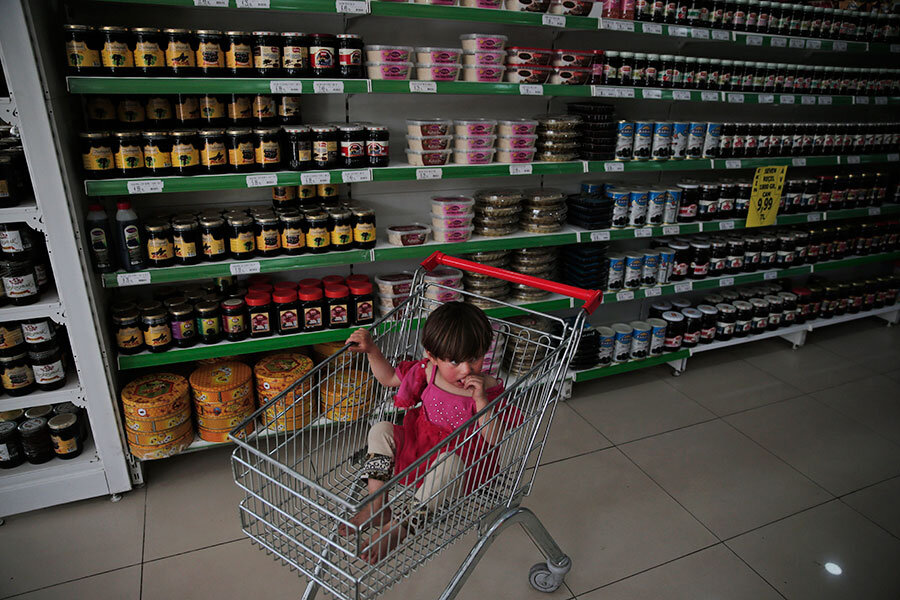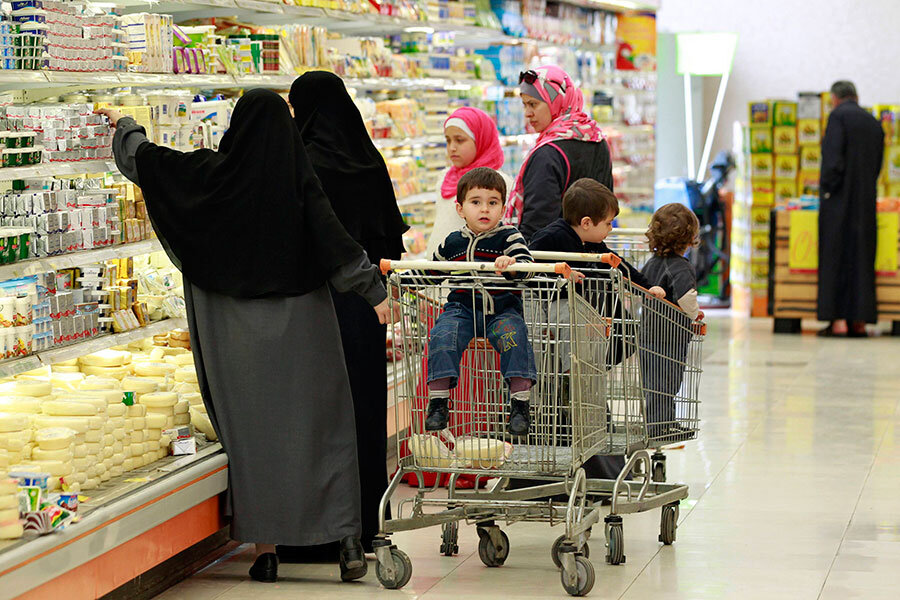The humanitarian revolution: Ensuring the 'dignity' of a job
| United Nations, N.Y. and Amman, Jordan
For Mohammed Hamsawi, it was hard enough simply trying to put food on his own family’s table. As a Syrian refugee, he had a modest stipend from the World Food Program, but it wasn’t enough. So he picked up illegal and irregular work as a plumber.
Then his brother was deported. He, too, had a family to feed, but when he was caught illegally working in construction for the third time, he was sent back to Syria.
Now, Mr. Hamsawi has to support his brother’s family of four as well as his own.
“We need three of us to work full-time to survive, but instead everyone is counting on my part-time work,” Hamsawi says. “All we want is to live in dignity and security. It is one thing we refuse the war to take from us.”
Hamsawi’s plight is common among the 1.3 million Syrian refugees in Jordan and the 60 million refugees and displaced people worldwide – the highest level since World War II. The average length of time that refugees are remaining outside their own country – and away from their careers and employment – is increasing. A 2003 United Nations report estimated that refugees spend an average of 17 years away from home.
In neighboring countries and beyond, Syrian refugees have confronted a patchwork of laws and practices concerning employment. Mostly they’ve faced closed doors.
But some signs of hope are beginning to emerge for those who want to work, provide for their families, and preserve what experts say is often the last piece of self-worth that male refugees in particular still hold.
The issue is viewed as so crucial for refugees’ well-being that it is expected to figure prominently in next week’s World Humanitarian Summit in Istanbul, Turkey. The summit was called by UN Secretary-General Ban Ki-moon to address what he refers to as the world’s unprecedented humanitarian crisis.
In the run-up to the summit, some countries with high numbers of Syrian refugees are loosening restrictions on employment and finding creative ways to put refugees to work.
As it turns out, the “dignity” of employment and the ability to provide for one’s family felt so strongly by Hamsawi is a guaranteed right for refugees under international law. More and more, humanitarian agencies and experts are paying attention to the effect of joblessness on the millions of people in Hamsawi’s predicament.
“International law … recognizes that being able to access work is fundamental to human dignity and central to survival and development of the human personality,” the International Rescue Committee notes in a recent overview of refugees’ right to work.
• • •
That right to work has remained largely on paper for millions of refugees.
As millions of Syrians have fled – 2.7 million to Turkey, 1.3 million to Jordan, 1.5 million to Lebanon – they have been relegated to jobs in informal sectors of economies, with the lower pay, exploitation, and insecurity that come with them.
But that picture is slowly starting to change.
Earlier this year, Turkey reversed a ban on Syrian refugee employment and granted the right to work legally to all Syrians who have registered as refugees in the country.
In February, Jordan ended a de facto five-year ban on employment for Syrians with a right-to-work accord with the European Union. Jordan will receive $2.1 billion in grants in exchange for opening its labor market to Syrians.
At the same time, a pilot project in Jordan between the International Labor Organization (ILO) and the UN High Commissioner for Refugees will initially create 2,000 jobs for Syrians in factories producing garments for American companies.
The garment industry program is seen as a win-win-win – for Syrians seeking work, for the beleaguered Jordanian economy, and for United States companies eager to burnish their image by playing even a small role in addressing the refugee crisis.
“US buyers saw this as humanitarian responsibility, and were eager to give Syrians a decent job, a decent income, and a decent life in Jordan,” says Tareq AbuQaoud, project manager and head of the ILO’s Better Work Jordan program.
Indeed, stepped-up private-sector involvement will be crucial in addressing the huge jobs gap refugees face, humanitarian experts say.
One example of how that involvement might work comes from a partnership between the American humanitarian organization CARE and Gap Inc. The pilot program targets vulnerable women for job training and skills building. For now, the program is limited to Jordanian women, but a recent report by a group of aid organizations including CARE suggests it as the kind of initiative that could be expanded to refugees, as well.
• • •
For their part, the countries easing work restrictions for refugees have motivations beyond philanthropy.
Turkish officials say they dropped the ban on employing Syrians partly because foreign employers were culling the best Syrian professionals and skilled workers to fill vacancies in their countries.
“Certain people used to come here on brain-hunting missions, taking the highly-qualified, educated [Syrians] to their countries,” Turkish government spokesman and Deputy Prime Minister Numan Kurtulmus said in January. “The Syrians are not just children selling tissues at traffic lights.”
And for the European Union, the motivation for a multibillion-dollar jobs accord with Jordan is clearly to keep refugees in their home region.
Moreover, countries remain leery of the effect that more open labor markets might have on domestic employment rates and wages – as well as politics, an International Rescue Committee report states. So they are keeping a tight grip on the refugee labor market.
In Turkey, the new law says refugees will be able to work only in the provinces where they reside. In addition, the number of Syrians at one workplace or jobsite is not to surpass 10 percent of the total.
In Jordan, the new work-for-refugees initiatives are seen as opening jobs that many Jordanians don’t want or which are already held by foreign workers, experts says.
For example, Jordan will open jobs in agriculture, construction, and basic services, which are currently dominated by a half-million foreign laborers. In the garment industry, the plan is to gradually replace many of the Bangladeshis, Sri Lankans, and Indians in the 60,000-job sector with Syrians.
But whatever the motivations behind the initiatives, it is acknowledgement that refugees facing a decade or two away from home can no longer be expected to put their lives on hold, experts say.
And as Hamsawi attests, a dignified life is one that includes work.
The humanitarian revolution
Part 1: Reimagining a colonial-era model
Part 2: The human 'dignity' of a job
Part 3: What happens when emergencies don't end?
Part 4: At UN summit, a new 'hope'






